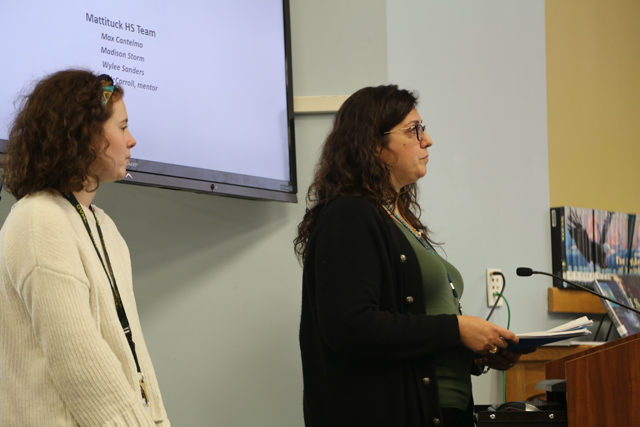Boots-deep in research: Mattituck students collect DNA samples


As soon as the school day ends, it smells like low tide.
A blustery wind rolls across the inlet at Marratooka Point, off Park Avenue in Mattituck. It ripples across the muddy water where three Mattituck High School seniors, wearing calf-high rain boots and waist-high waders, stand.
Seniors Wylee Sanders and Madison Storm stand close to the shoreline, scooping handfuls of muddy water and bringing them to Mattituck High School science teacher Anna McCarroll. She uses a pipe dropper tool to funnel samples into test tubes. She doesn’t know it yet, but one of the tubes has two snails in it.
Senior Max Cantelmo wades farther into the water with a plankton net, dragging it along the shallow water. He’s looking for any sign of movement from minuscule white creatures that dart back and forth.
The volunteer students are searching for amphipods, shrimp-like crustaceans that live in salt and freshwater environments. There are over 9,900 different species that vary based on location.
The group has been collecting samples since their research proposal, “Amphipod Diversity in Two Bay Estuaries in Mattituck, New York: Farmland vs. Residential,” was accepted in February 2019 by Barcode Long Island, a project run by the Dolan DNA Learning Center at Cold Spring Harbor Laboratory. The students do not receive academic credit for their efforts; they use their free time after school and on weekends purely for research experience, Ms. McCaroll said.
Their proposal explores nitrogen levels, determined by the quantity of amphipods, in water taken from two environments: the more residentially located inlet at Marratooka Point and Wickham Creek, which is surrounded by farmland, Ms. McCarroll said.
The proposal is one of many student-run DNA-based projects that are part of Barcode Long Island, the teacher said, which aim to map and track different species in Long Island’s ecosystems.
“The project is centered on every living thing [that] has DNA,” Ms. McCarroll said. “If we can extract the DNA from a nucleus, we can also catalog the DNA and we have a certain type of animal or plant. That cataloging shows what biodiversity we have on Long Island.”

The research projects are funded by the National Institutes of Health, Brookhaven National Laboratory and the American Museum of Natural History, and in collaboration with Stony Brook University — Ms. McCarroll’s alma mater, where she received a degree in biology with a minor in medicine and society in 1990.
To date, most student research has been conducted in Nassau County, Ms. McCarroll said, which motivated her to bring the program to Mattituck with help from fellow teachers. She has also volunteered with Cold Spring Harbor Laboratory for the past two years.
“It’s out-of-the-box, monitored learning,” she said.
Earlier this month, Madison, Max and Ms. McCarroll outlined their research for the Mattituck-Cutchogue Board of Education.
DNA barcoding involves identifying the unique pattern of the DNA sequence that identifies each living organism, Max told board members.
“It allows us to look for a particular gene,” he explained, “which in turn is dependent on the species and has its own particular pattern. Then, we go in and sequence that, which tells us what that pattern is. From there, we can identify the species of arthropod we’re dealing with.”
This week is crunch time, Ms. McCarroll said, as the group has until Thursday, May 2, to gather samples. The samples are then sent to the bioinformatics team at the lab, which conducts research using DNA extraction, gel electrophoresis and other methods. The results are then returned to the student teams.
On June 4, the Mattituck students will present their findings at the laboratory with other student groups.
Top Caption: Mattituck High School seniors (from left) Max Cantelmo, Wylee Sanders and Madison Storm collect samples at Wickham Creek Monday for their DNA research proposal, ‘Amphipod Diversity in Two Bay Estuaries in Mattituck, New York: Farmland vs. Residential.’ The project will be presented June 4 at Cold Spring Harbor Laboratory. (Credit: Anna McCarroll)








